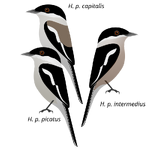| Jacamars | |
|---|---|

| |
| Rufous-tailed Jacamar (Galbula ruficauda) | |
| Scientific classification | |
| Kingdom: | Animalia |
| Phylum: | Chordata |
| Class: | Aves |
| Clade: | Inopinaves |
| Clade: | Afroaves |
| Order: | Piciformes |
| Family: | Galbulidae Vigors, 1825 |
| Genera | |
The jacamars are a family, Galbulidae, of near passerine birds from tropical South and Central America, extending up to Mexico. The order contains five genera and 18 species. The family is closely related to the puffbirds, another Neotropical family, and the two families are often separated into their own order away from the Piciformes, instead being placed in the Galbuliformes. They are principally birds of low altitude woodlands and forests, and particularly of forest edge and canopy.
Description[]
The jacamars are small to medium sized perching birds ranging between 14–34 cm (5.5–13.4 in) in length and weighing between 17–76 g (0.60–2.68 oz).[1] Small to medium-sized slender birds with tiny feet, with rounded wings, and very long bill used to catch insects in flight. Their plumage varies from brightly coloured and iridescent to fairly dull.[1]
They are glossy elegant birds with long bills and tails. In appearance and behaviour they show resemblances to the Old World bee-eaters, as most ariel insectivores tend to have short wide bills as opposed to long thin ones. The legs are short and weak, and the feet are zygodactyl. Their plumage is often bright and highly iridescent, although it is quite dull in a few species. There are minor differences in plumage based on sex, males often having a white patch on the breast.[2]
Behaviour[]
Diet and feeding[]
Jacamars are insectivores, taking a variety of insect prey (many specialize on butterflies and moths) by hawking in the air. Birds sit in favoured perches and sally towards the prey when it is close enough. Only the Great Jacamar varies from the rest of the family, taking prey by gleaning and occasionally taking small lizards and spiders.[2]
Breeding[]
The breeding systems of jacamars have not been studied in depth. They are thought to generally be monogamous, although a few species are thought to sometimes engage in cooperative breeding with several adults sharing duties. The family nests in holes either in the soil or in arboreal termite mounds. Ground nesting species usually nest in the banks of rivers (or more recently, roads), although if these are not available they will nest in the soil held by the roots of fallen trees. Bank-nesting jacamars can sometimes be loosely colonial. Clutch sizes are between 1-4 eggs, with 2-4 being more common. Both parents participate in incubation. Little is known about the incubation times of most species, although it lasts for between 19–26 days in the Rufous-tailed Jacamar. Chicks are born with down feathers, unique among the piciformes.[2]
Species[]
FAMILY: GABULIDAE
- Genus: Galbalcyrhynchus
- White-eared Jacamar, Galbalcyrhynchus leucotis
- Purus Jacamar, Galbalcyrhynchus purusianus
- Genus: Brachygalba
- Dusky-backed Jacamar, Brachygalba salmoni
- Pale-headed Jacamar, Brachygalba goeringi
- Brown Jacamar, Brachygalba lugubris
- White-throated Jacamar, Brachygalba albogularis
- Genus: Jacamaralcyon
- Three-toed Jacamar, Jacamaralcyon tridactyla
- Genus: Galbula
- Yellow-billed Jacamar, Galbula albirostris
- Blue-necked Jacamar, Galbula cyanicollis
- Rufous-tailed Jacamar, Galbula ruficauda
- Green-tailed Jacamar, Galbula galbula
- Coppery-chested Jacamar, Galbula pastazae
- Bluish-fronted Jacamar, Galbula cyanescens
- White-chinned Jacamar, Galbula tombacea
- Purplish Jacamar, Galbula chalcothorax
- Bronzy Jacamar, Galbula leucogastra
- Paradise Jacamar, Galbula dea
- Spot-tailed Jacamar, Galbula rufoviridis
- Genus: Jacamerops
- Great Jacamar, Jacamerops aureus
References[]
- ^ a b Tobias, J.; Züchner T. & T.A. de Melo Júnior (2013) "Family Galbulidae (Jacamars)". in del Hoyo, J.; Elliot, A. & Sargatal, J. (editors). (2013). Handbook of the Birds of the World Alive. Lynx Edicions, Barcelona. (retrieved from http://www.hbw.com/family/jacamars-galbulidae on 3 April 2015).
- ^ a b c Tobias, J.; Züchner T. & T.A. de Melo Júnior (2002) "Family Galbulidae (Jacamars)". in del Hoyo, J.; Elliot, A. & Sargatal, J. (editors). (2002). Handbook of the Birds of the World. Volume 7: Jacamars to Woodpeckers. Lynx Edicions. ISBN 84-87334-37-7
External links[]
- Jacamar videos on the Internet Bird Collection
| ||||||||||||||||||||||||||||||||||||||||||||

|
This article is part of Project Bird Families, a All Birds project that aims to write comprehensive articles on each bird family, including made-up families. |

|
This article is part of Project Bird Taxonomy, a All Birds project that aims to write comprehensive articles on every order, family and other taxonomic rank related to birds. |
| This page uses Creative Commons Licensed content from Wikipedia (view authors). Please help by writing it in the style of All Birds Wiki! |
